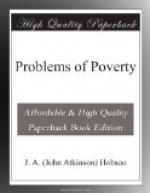It is in its bearing on the industrial condition of the very poor, and those who are unable to get regular work at decent wages, that the influence of machinery is most questionable. Violent trade fluctuations, and a continuous displacement of hand-labour by new mechanical inventions, keep in perpetual existence a large margin of unemployed or half-employed, who form the most hopeless and degraded section of the city poor, and furnish a body of reckless, starving competitors for work, who keep down the standard of wages and of life for the lower grades of regular workers affected by this competition.
Chapter III.
The Influx of Population into Large Towns.
Sec. 1. Movements of Population between City and Country. The growth of large cities is so closely related to the problems of poverty as to deserve a separate treatment. The movements of population form a group of facts more open than most others to precise measurement, and from them much light is thrown on the condition of the working classes. That the towns are growing at the expense of the country, is a commonplace to which we ought to seek to attach a more definite meaning.
We may trace the inflow of country-born people into the towns by looking either at the statistics of towns, or of rural districts. But first we ought to bear in mind one fact. Quite apart from any change in proportion of population, there is an enormous interchange constantly taking place between adjoining counties and districts. The general fluidity of population has been of course vastly increased by new facilities of communication and migration; persons are less and less bound down to the village or county in which they were born. So we find that in England and Wales, only 739 out of each 1000 persons were living in their native county in 1901. In some London districts it is reckoned that more than one quarter of the inhabitants change their address each year. So that when we are told that in seven large Scotch towns only 524 out of each 1000 are natives, and that in Middlesex only 35 per cent. of the male adult population are Middlesex by birth, we are not thereby enabled to form any conclusion as to the growth of towns.
To arrive at any useful result we must compare the inflow with the outflow. Most of the valuable information we possess on this point applies directly to London but the same forces which are operating in London, will be found to be at work with more or less intensity in other centres of population in proportion to their size. Comparing the inflow of London with its outflow, we find that in 1881 nearly twice as many strangers were living in London as Londoners were living outside; in other words, that London was gaining from the country at the rate of more than 10,000 per annum. So far as London itself is concerned, the last two censuses show a cessation of the flow, but the enormous growth of Middlesex outside the metropolitan boundaries indicates a continuance of the centripetal tendency.




